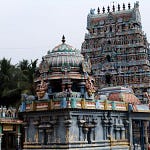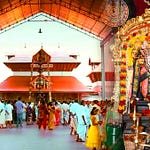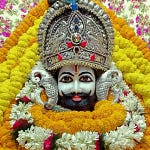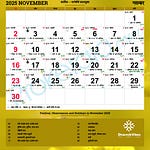Charan Paduka Temple, located on the sacred trail from Katra to the holy Vaishno Devi Bhawan in Jammu and Kashmir, holds profound spiritual reverence in the hearts of Hindu devotees. This temple is not just a stopover on the famed Vaishno Devi Yatra; it is a tirtha (pilgrimage spot) in its own right—imbued with legends, divine footprints, and a celestial aura that leaves pilgrims spellbound.
🌄 Geography and Location
Charan Paduka Temple is situated approximately 1.5 km from Banganga and 1.2 km from Ardhkuwari Cave, at an altitude of 3,380 feet (1,030 meters) above sea level. The temple lies amidst the forested hills of Trikuta Parvat, providing pilgrims with a peaceful, scenic, and spiritually charged environment. The pathway is well-laid and forms an integral milestone of the 13.5 km trek from Katra to Vaishno Devi Bhawan.
🕉️ Mythological and Historical Significance
The word “Charan Paduka” literally translates to “sacred footprints”. As per Hindu mythology, Mata Vaishno Devi, while being pursued by the demon Bhairavnath, stopped briefly at this location. In that divine moment, her footprints were permanently etched on a rock, symbolizing her presence and protection.
Pilgrims believe that offering prayers at Charan Paduka helps invoke the Goddess’s blessings for protection, healing, and spiritual elevation. These sacred imprints serve as a physical manifestation of the Goddess’s journey on earth and reinforce devotees' faith.
🛕 Temple Architecture and Foundation
The Charan Paduka Temple is a small shrine built around the footprint-shaped impressions preserved on a large boulder. The structure is simple yet sacred. A transparent glass covering protects the footprints, allowing devotees to offer darshan without physical contact. The shrine is managed by the Shri Mata Vaishno Devi Shrine Board, which also manages the entire Vaishno Devi pilgrimage infrastructure.
🔱 Rituals, Pujas, and Grah Dosha Remedies
Daily Rituals and Pujas:
Mangala Aarti: Early morning aarti performed to the divine footprints.
Pushpanjali: Devotees offer fresh flowers while chanting Devi mantras.
Lighting Diya: Lighting of oil lamps for divine blessings.
Charan Sparsh (symbolic): Though actual touch is restricted, devotees symbolically bow to the footprints.
Grah Dosh Puja:
While Charan Paduka is not a dedicated grah shanti center, many devotees with specific grah doshas like Rahu, Ketu, Shani, or Chandra Dosh pause here to:
Offer navagraha-related flowers and oils.
Recite Durga Saptashati, Devi Kavach, or Navarna Mantra (ॐ ऐं ह्रीं क्लीं चामुण्डायै विच्चे).
Seek protection from evil eyes, ancestral curses, and karmic blocks, as Mata Vaishno is believed to be a form of Adi Shakti, who governs all navagrahas.
🎉 Festivals Celebrated
Navratri (Chaitra & Sharad) – The most important time when thousands of pilgrims trek to Vaishno Devi, stopping at Charan Paduka for blessings.
Durga Ashtami and Maha Navami – Special rituals and chanting sessions.
Diwali and Holi – Celebrated with bhajans and diya offerings.
🌿 Spiritual and Tirtha Importance
Charan Paduka is one of the three sacred intermediate halts on the yatra:
Banganga – Where Mata quenched her thirst.
Charan Paduka – Where she left her footprints.
Ardhkuwari – Where she meditated in a cave for 9 months.
The spot is a spiritual accelerator – a place where your intentions, prayers, and mantras are believed to manifest with greater speed and intensity. It is said that pausing here helps:
Remove spiritual blockages.
Grant inner peace and courage.
Reconnect with divine feminine energy.
🧭 Nearby Attractions
Banganga Temple – Origin of the sacred river.
Ardhkuwari Cave – Site of meditation for Mata for 9 months.
Sanjichhat – The highest point before Bhawan.
Bhawan (Vaishno Devi Temple) – Main shrine of the Goddess.
Bhairon Nath Temple – Final stop post darshan for complete pilgrimage.
🚶♀️ How to Visit – Travel Guide
Nearest Town:
Katra, in Reasi district, is the base station for the Vaishno Devi Yatra.
Modes of Travel:
By Air: Nearest airport – Jammu Airport (50 km from Katra).
By Rail: Shri Mata Vaishno Devi Railway Station, Katra.
By Road: Well-connected by buses, taxis, and private vehicles from Jammu, Delhi, Punjab, and Himachal.
Trek Information:
Start from Darshani Darwaza.
Charan Paduka is located approx 1.5 km uphill from Banganga.
The trail is concrete and shaded with regular water booths and resting spots.
🧘♂️ Best Time to Visit
March–April (Chaitra Navratri) and September–October (Sharad Navratri) are peak spiritual seasons.
Avoid monsoon (July–August) due to slippery paths and landslides.
🙏 Devotee Tips
Carry light woollens and walking sticks.
Keep Devi mantras or bhajans on headphones to stay motivated.
Stop at Charan Paduka to meditate for a few minutes—many report visions, peace, or deep emotions here.
If suffering from Rahu/Ketu dosha, bring blue/black cloth, sesame oil, or iron nails to symbolically offer at the shrine.
The Charan Paduka Temple is much more than a physical waypoint—it's a celestial echo of the divine feminine energy that continues to bless and protect those who embark on the Vaishno Devi Yatra. A symbol of faith, surrender, and spiritual awakening, Charan Paduka teaches every devotee that even the footprints of divinity are enough to guide one’s path through life.










